Resident Crews of Salyut 3
![]()
Salyut 3 |
 |
 |
 |
alternative crew photo |
alternative crew photo |
alternative crew photo |
alternative crew photo |
alternative crew photo |
![]()
Crew, launch- and landing data
| No. | Nation | Surname | Given names | Position | Spacecraft (launch) |
Launch date |
Launch time |
Spacecraft (landing) |
Landing date |
Landing time |
Mission duration |
Orbits |
| 1 | Popovich | Pavel Romanovich | Commander | Soyuz 14 | 03.07.1974 | 18:51:08 UTC | Soyuz 14 | 19.07.1974 | 12:21:36 UTC | 15d 17h 30m 28s | 252 | |
| 2 | Artyukhin | Yuri Petrovich | Flight Engineer | Soyuz 14 | 03.07.1974 | 18:51:08 UTC | Soyuz 14 | 19.07.1974 | 12:21:36 UTC | 15d 17h 30m 28s | 252 |
1st Backup Crew
| No. | Nation | Surname | Given names | Position |
| 1 | Sarafanov | Gennadi Vasiliyevich | Commander | |
| 2 | Dyomin | Lev Stepanovich | Flight Engineer |
 |
2nd Backup Crew
| No. | Nation | Surname | Given names | Position |
| 1 | Volynov | Boris Valentinovich | Commander | |
| 2 | Zholobov | Vitali Mikhailovich | Flight Engineer |
 |
Expedition Report
|
Launch from the Baikonur Cosmodrome and
landing 140 km southeast of Dzheskasgan. Following a one-day solo flight Soyuz 14 docked with the space station Salyut 3 on July 04, 1974. The crew transferred into the space station and stayed there 14 days. Presumable military activities (observation of rocket bases) and some medical and biological experiments were done. The cosmonauts exercised for 2 hours each day to counter the effects of weightlessness. At the time, the military nature of this mission and the station itself were not acknowledged by Soviet authorities. Increased solar activity raised safety issues, but it was decided radiation levels were within safe limits, so the flight continued. Experiments were described by the Soviets, but analysts presumed that much time was taken up with unreported military activities. Claims were made in the aerospace press that objects were laid out at the Baikonur Cosmodrome to photograph to test a high-resolution camera system on board. Some of the experiments the Soviets described included studies of the heart and circulatory systems in orbit, studies of intracranial pressure, monitoring of blood composition, measuring of lung capacity and inhalation/exhalation rates and the testing of a water purification system which condensed moisture from the station's atmosphere All objectives were successfully completed. The Soyuz spacecraft is composed of three elements attached end-to-end - the Orbital Module, the Descent Module and the Instrumentation/Propulsion Module. The crew occupied the central element, the Descent Module. The other two modules are jettisoned prior to re-entry. They burn up in the atmosphere, so only the Descent Module returned to Earth. Having shed two-thirds of its mass, the Soyuz reached Entry Interface - a point 400,000 feet (121.9 kilometers) above the Earth, where friction due to the thickening atmosphere began to heat its outer surfaces. With only 23 minutes left before it lands on the grassy plains of central Asia, attention in the module turned to slowing its rate of descent. Eight minutes later, the spacecraft was streaking through the sky at a rate of 755 feet (230 meters) per second. Before it touched down, its speed slowed to only 5 feet (1.5 meter) per second, and it lands at an even lower speed than that. Several onboard features ensure that the vehicle and crew land safely and in relative comfort. Four parachutes, deployed 15 minutes before landing, dramatically slowed the vehicle's rate of descent. Two pilot parachutes were the first to be released, and a drogue chute attached to the second one followed immediately after. The drogue, measuring 24 square meters (258 square feet) in area, slowed the rate of descent from 755 feet (230 meters) per second to 262 feet (80 meters) per second. The main parachute was the last to emerge. It is the largest chute, with a surface area of 10,764 square feet (1,000 square meters). Its harnesses shifted the vehicle's attitude to a 30-degree angle relative to the ground, dissipating heat, and then shifted it again to a straight vertical descent prior to landing. The main chute slowed the Soyuz to a descent rate of only 24 feet (7.3 meters) per second, which is still too fast for a comfortable landing. One second before touchdown, two sets of three small engines on the bottom of the vehicle fired, slowing the vehicle to soften the landing. The capsule landed within 2 km of the aim point. |
Photos / Graphics
 |
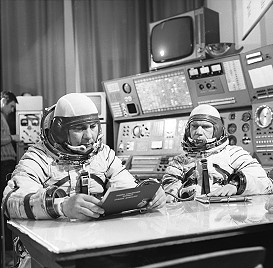 |
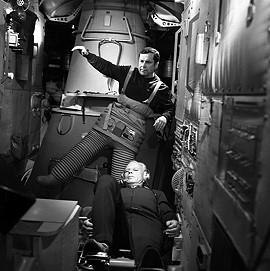 |
 |
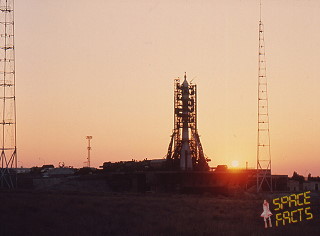 |
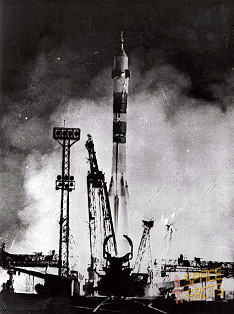 |
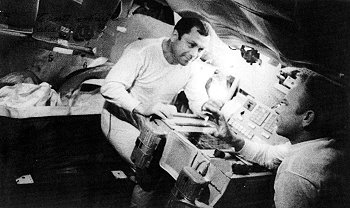 |
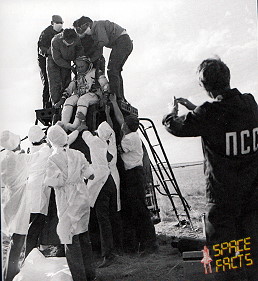 |
| © | 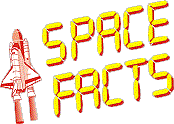 |
Last update on August 26, 2024.  |
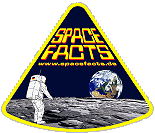 |